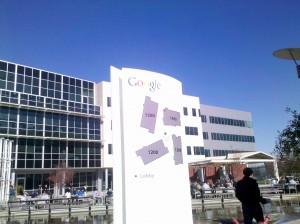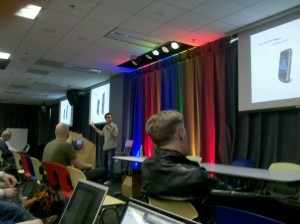I got to go to the dayofjs conference (thanks MJG!) Not only was the conference really interesting, but I also got to hang out at Google which was cool. So, I snapped a few pics, as one does.
This is where I found out that I parked about as far as I could have from where I wanted to be.
Google lunch.
Can’t really complain about the day
Ahh, the free beverage fridge
This doesn’t have anything to do with Google or Dayofjs, but I got In-and-Out on my way home after being stuck in traffic for 2 hours, because it has been a long time since I have had it.
The mobile talks of the day were about:
Sencha Touch: http://www.sencha.com/products/touch/
Appcelerator’s Titanium: http://www.appcelerator.com/
jQuery Mobile: http://jquerymobile.com/
There was also a fair amount of talk about PhoneGap: http://www.phonegap.com/
Yehuda Katz also gave a talk about Sproutcore that was really good. It was not really a mobile talk, but it was still very informative and interesting.








Hello! Just want to say thank you for this interesting article! =) Peace, Joy.
From what I’ve gathered, here are some defcirenfes between the two: PhoneGap basically generates native wrappers for what are still web apps. It spits out a WhateverYourPlatformIs project, you build it, and deploy. If we’re talking about the iPhone (which is where I spend my time), it doesn’t seem much different from creating a web app launcher (a shortcut that gets its own Springboard icon, so you can launch it like (like) a native app). The app itself is still html/js/etc., and runs inside a hosted browser control. What PhoneGap provides beyond that is a bridge between JavaScript and native device APIs. So, you write JavaScript against PhoneGap APIs, and PhoneGap then makes the appropriate corresponding native call. In that respect, it is different from deploying a plain old web app. Titanium source gets compiled down to native bits. That is, your html/js/etc. aren’t simply attached to a project and then hosted inside a web browser control they’re turned into native apps. That means, for example, that your app’s interface will be composed of native UI components. There are ways of getting native look-and-feel without having a native app, but well what a nightmare that usually turns out to be.The two are similar in that you write all your stuff using typical web technologies (html/js/css/blah blah blah), and that you get access to native functionality through custom JavaScript APIs.But, again, PhoneGap apps (PhonGapps? I don’t know is that a stupid name? It’s easier to say I know that much) start their lives as web apps and end their lives as web apps. On the iPhone, your html/js/etc. is just executed inside a UIWebView control, and the PhoneGap JavaScript APIs your js calls are routed to native APIs.Titanium apps become native apps they’re just developed using web dev tech.What does this actually mean? A Titanium app will look like a real app because, ultimately, it is a real app. A PhoneGap app will look like a web app being hosted in a browser control because, ultimately, it is a web app being hosted in a browser control.Which is right for you? If you want to write native apps using web dev skills, Titanium is your best bet. If you want to write an app using web dev skills that you could realistically deploy to multiple platforms (iPhone, Android, Blackberry, and whatever else they decide to include), and if you want access to a subset of native platform features (GPS, accelerometer, etc.) through a unified JavaScript API, PhoneGap is probably what you want.You might be asking: Why would I want to write a PhoneGapp (I’ve decided to use the name) rather than a web app that’s hosted on the web? Can’t I still access some native device features that way, but also have the convenience of true web deployment rather than forcing the user to download my native app and install it?The answer is: Because you can submit your PhoneGapp to the App Store and charge for it. You also get that launcher icon, which makes it harder for the user to forget about your app (I’m far more likely to forget about a bookmark than an app icon).You could certainly charge for access to your web-hosted web app, but how many people are really going to go through the process to do that? With the App Store, I pick an app, tap the Buy button, enter a password, and I’m done. It installs. Seconds later, I’m using it. If I had to use someone else’s one-off mobile web transaction interface, which likely means having to tap out my name, address, phone number, CC number, and other things I don’t want to tap out, I almost certainly wouldn’t go through with it. Also, I trust Apple I’m confident Steve Jobs isn’t going to log my info and then charge a bunch of naughty magazine subscriptions to my CC for kicks.Anyway, except for the fact that web dev tech is involved, PhoneGap and Titanium are very different to the point of being only superficially comparable.I hate web apps, by the by, and if you read iTunes App Store reviews, users are pretty good at spotting them. I won’t name any names, but I have a couple apps on my phone that look and run like garbage, and it’s because they’re web apps that are hosted inside UIWebView instances. If I wanted to use a web app, I’d open Safari and, you know, navigate to one. I bought an iPhone because I want things that are iPhone-y. I have no problem using, say, a snazzy Google web app inside Safari, but I’d feel cheated if Google just snuck a bookmark onto Springboard by presenting a web app as a native one.Have to go now. My girlfriend has that could-you-please-stop-using-that-computer-for-three-seconds look on her face.link|improve this answeranswered Oct 4 ’09 at 3:49Rory Blyth